Diabetes Health Promotion: Review of Effective Strategies in Australia
VerifiedAdded on 2020/04/01
|9
|2102
|100
Report
AI Summary
This report presents a systematic review of health promotion strategies for diabetes in Australia, aiming to identify effective interventions for prevention and management. The study analyzed ten articles published between 2011 and 2017, revealing challenges such as poor self-management, lack of awareness, and the impact of lifestyle factors on diabetes prevalence. The review highlights the need for targeted interventions, emphasizing community engagement, one-to-one counseling, and lifestyle modifications, including diet, physical activity, and self-management education. The report suggests implementing free health checks and glucose monitoring camps to assess the targeted population and explore factors contributing to non-compliance. Furthermore, the report recommends behavior change strategies, such as yoga and jogging sessions, along with regular counseling sessions by healthcare professionals and community workers. The conclusion emphasizes the importance of future research to support type 2 diabetes prevention and improve compliance with healthy lifestyles among individuals in Australia.
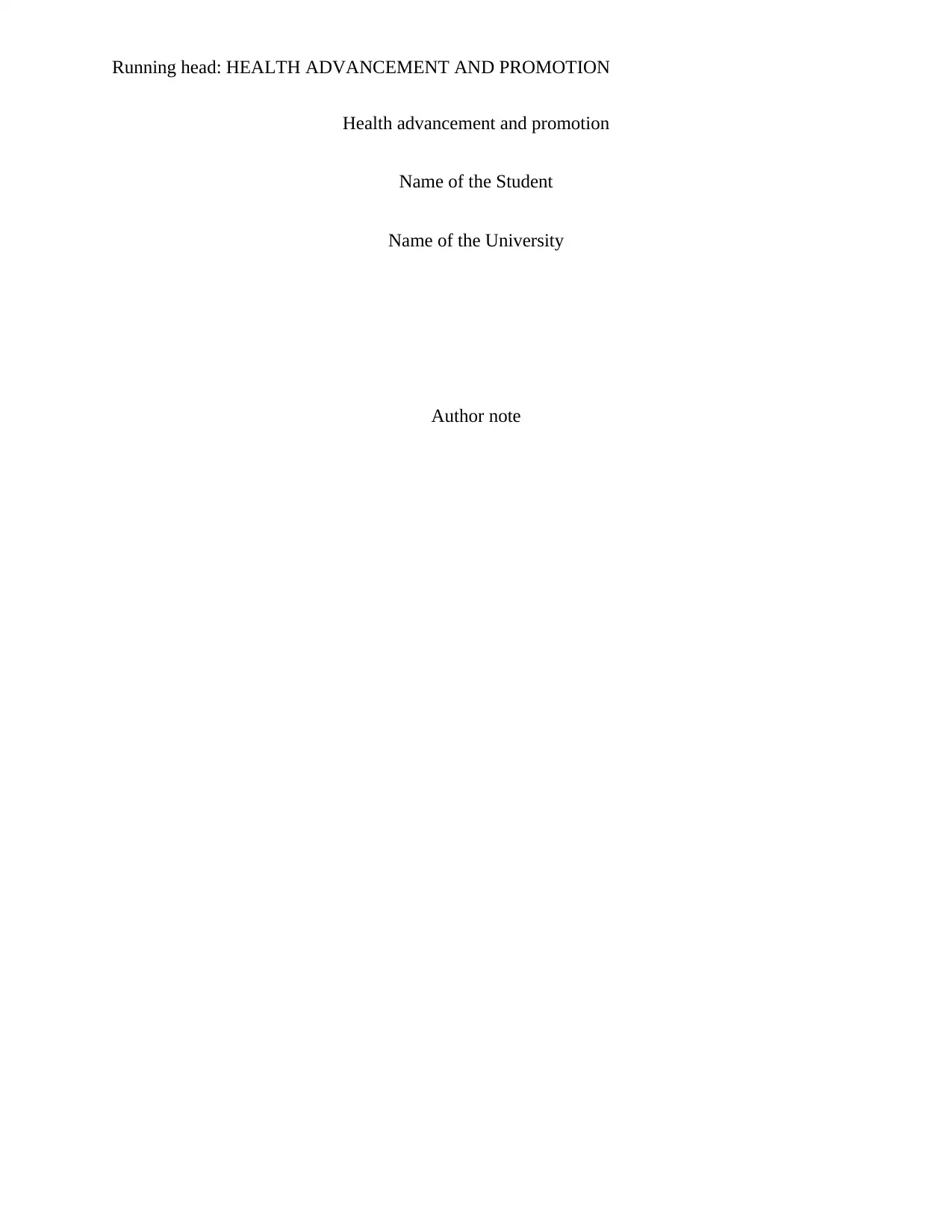
Running head: HEALTH ADVANCEMENT AND PROMOTION
Health advancement and promotion
Name of the Student
Name of the University
Author note
Health advancement and promotion
Name of the Student
Name of the University
Author note
Paraphrase This Document
Need a fresh take? Get an instant paraphrase of this document with our AI Paraphraser
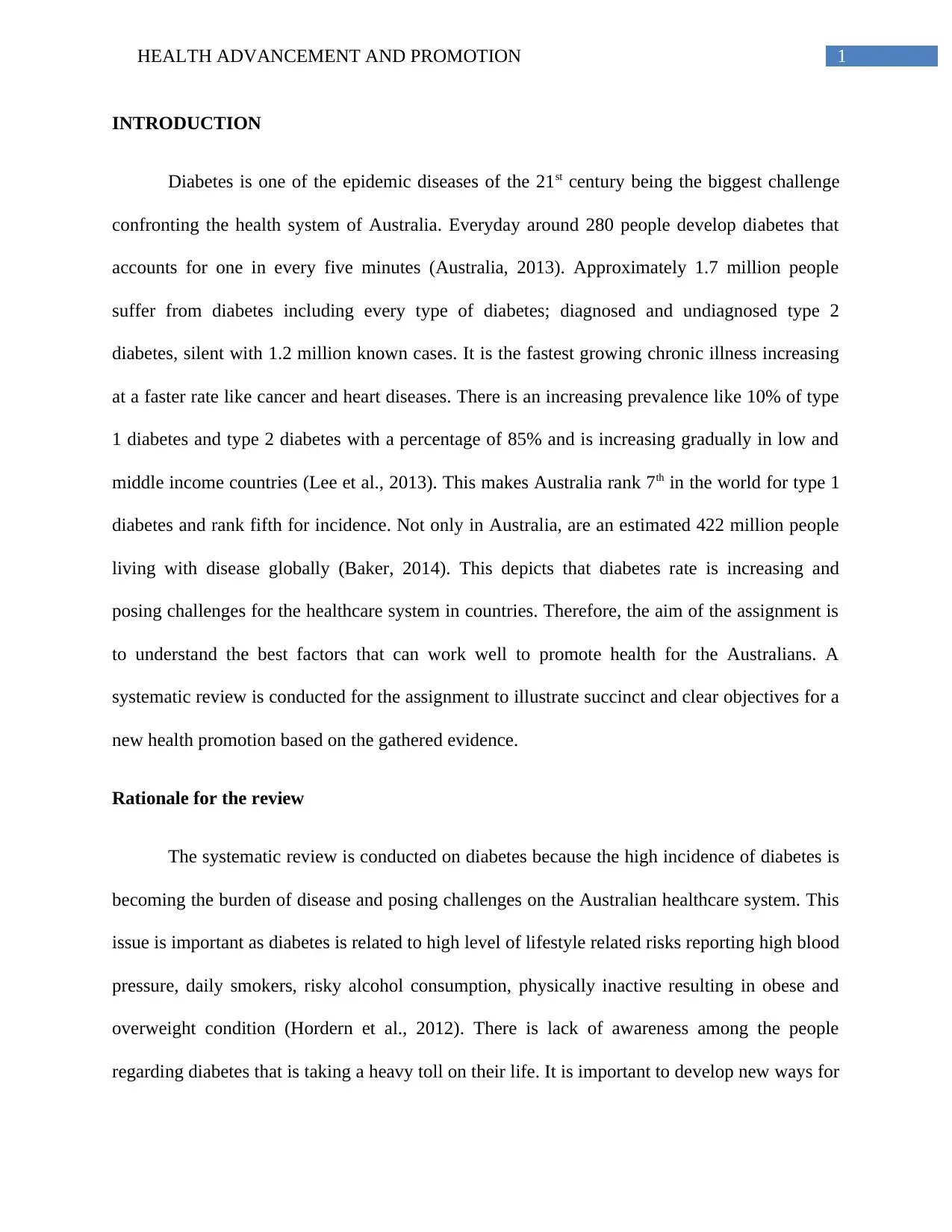
1HEALTH ADVANCEMENT AND PROMOTION
INTRODUCTION
Diabetes is one of the epidemic diseases of the 21st century being the biggest challenge
confronting the health system of Australia. Everyday around 280 people develop diabetes that
accounts for one in every five minutes (Australia, 2013). Approximately 1.7 million people
suffer from diabetes including every type of diabetes; diagnosed and undiagnosed type 2
diabetes, silent with 1.2 million known cases. It is the fastest growing chronic illness increasing
at a faster rate like cancer and heart diseases. There is an increasing prevalence like 10% of type
1 diabetes and type 2 diabetes with a percentage of 85% and is increasing gradually in low and
middle income countries (Lee et al., 2013). This makes Australia rank 7th in the world for type 1
diabetes and rank fifth for incidence. Not only in Australia, are an estimated 422 million people
living with disease globally (Baker, 2014). This depicts that diabetes rate is increasing and
posing challenges for the healthcare system in countries. Therefore, the aim of the assignment is
to understand the best factors that can work well to promote health for the Australians. A
systematic review is conducted for the assignment to illustrate succinct and clear objectives for a
new health promotion based on the gathered evidence.
Rationale for the review
The systematic review is conducted on diabetes because the high incidence of diabetes is
becoming the burden of disease and posing challenges on the Australian healthcare system. This
issue is important as diabetes is related to high level of lifestyle related risks reporting high blood
pressure, daily smokers, risky alcohol consumption, physically inactive resulting in obese and
overweight condition (Hordern et al., 2012). There is lack of awareness among the people
regarding diabetes that is taking a heavy toll on their life. It is important to develop new ways for
INTRODUCTION
Diabetes is one of the epidemic diseases of the 21st century being the biggest challenge
confronting the health system of Australia. Everyday around 280 people develop diabetes that
accounts for one in every five minutes (Australia, 2013). Approximately 1.7 million people
suffer from diabetes including every type of diabetes; diagnosed and undiagnosed type 2
diabetes, silent with 1.2 million known cases. It is the fastest growing chronic illness increasing
at a faster rate like cancer and heart diseases. There is an increasing prevalence like 10% of type
1 diabetes and type 2 diabetes with a percentage of 85% and is increasing gradually in low and
middle income countries (Lee et al., 2013). This makes Australia rank 7th in the world for type 1
diabetes and rank fifth for incidence. Not only in Australia, are an estimated 422 million people
living with disease globally (Baker, 2014). This depicts that diabetes rate is increasing and
posing challenges for the healthcare system in countries. Therefore, the aim of the assignment is
to understand the best factors that can work well to promote health for the Australians. A
systematic review is conducted for the assignment to illustrate succinct and clear objectives for a
new health promotion based on the gathered evidence.
Rationale for the review
The systematic review is conducted on diabetes because the high incidence of diabetes is
becoming the burden of disease and posing challenges on the Australian healthcare system. This
issue is important as diabetes is related to high level of lifestyle related risks reporting high blood
pressure, daily smokers, risky alcohol consumption, physically inactive resulting in obese and
overweight condition (Hordern et al., 2012). There is lack of awareness among the people
regarding diabetes that is taking a heavy toll on their life. It is important to develop new ways for
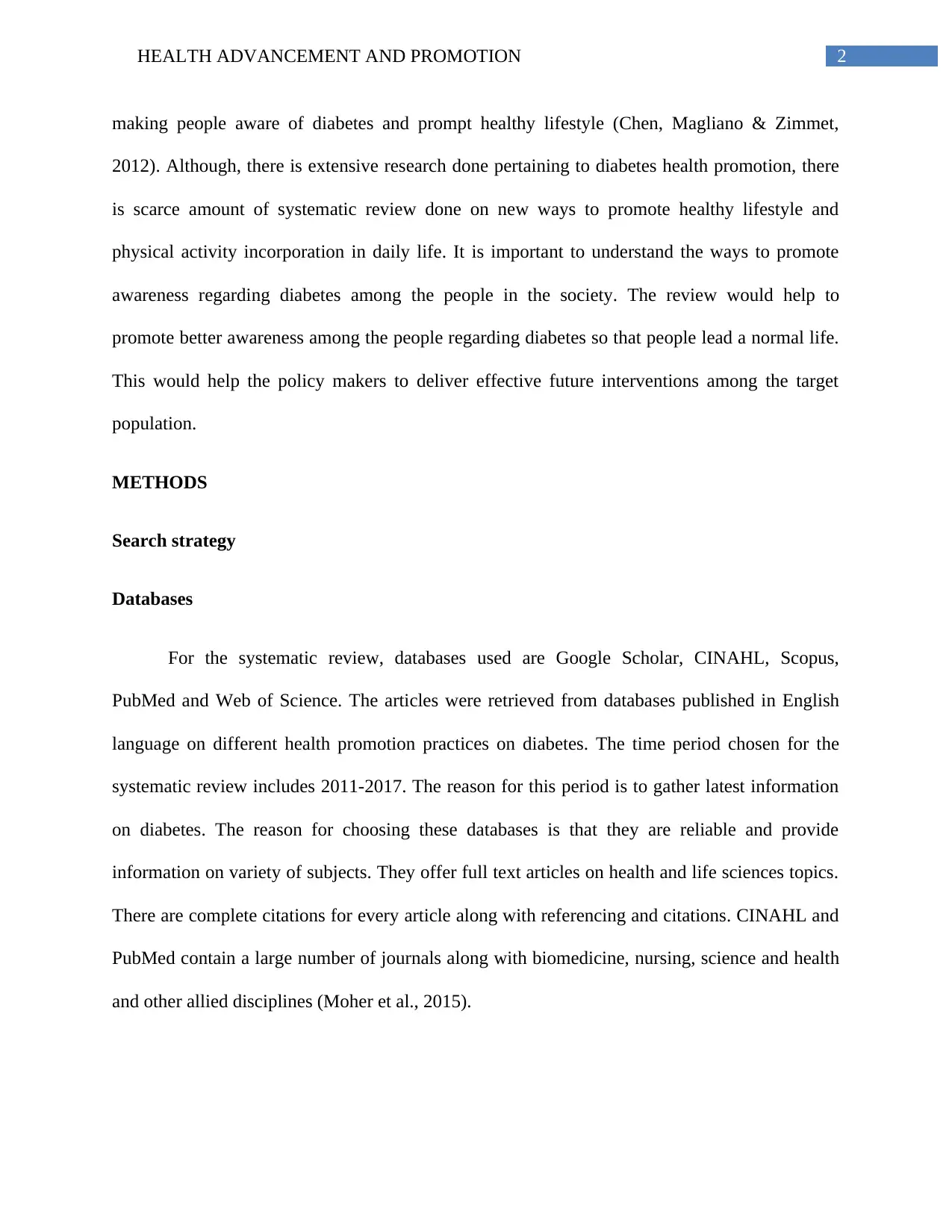
2HEALTH ADVANCEMENT AND PROMOTION
making people aware of diabetes and prompt healthy lifestyle (Chen, Magliano & Zimmet,
2012). Although, there is extensive research done pertaining to diabetes health promotion, there
is scarce amount of systematic review done on new ways to promote healthy lifestyle and
physical activity incorporation in daily life. It is important to understand the ways to promote
awareness regarding diabetes among the people in the society. The review would help to
promote better awareness among the people regarding diabetes so that people lead a normal life.
This would help the policy makers to deliver effective future interventions among the target
population.
METHODS
Search strategy
Databases
For the systematic review, databases used are Google Scholar, CINAHL, Scopus,
PubMed and Web of Science. The articles were retrieved from databases published in English
language on different health promotion practices on diabetes. The time period chosen for the
systematic review includes 2011-2017. The reason for this period is to gather latest information
on diabetes. The reason for choosing these databases is that they are reliable and provide
information on variety of subjects. They offer full text articles on health and life sciences topics.
There are complete citations for every article along with referencing and citations. CINAHL and
PubMed contain a large number of journals along with biomedicine, nursing, science and health
and other allied disciplines (Moher et al., 2015).
making people aware of diabetes and prompt healthy lifestyle (Chen, Magliano & Zimmet,
2012). Although, there is extensive research done pertaining to diabetes health promotion, there
is scarce amount of systematic review done on new ways to promote healthy lifestyle and
physical activity incorporation in daily life. It is important to understand the ways to promote
awareness regarding diabetes among the people in the society. The review would help to
promote better awareness among the people regarding diabetes so that people lead a normal life.
This would help the policy makers to deliver effective future interventions among the target
population.
METHODS
Search strategy
Databases
For the systematic review, databases used are Google Scholar, CINAHL, Scopus,
PubMed and Web of Science. The articles were retrieved from databases published in English
language on different health promotion practices on diabetes. The time period chosen for the
systematic review includes 2011-2017. The reason for this period is to gather latest information
on diabetes. The reason for choosing these databases is that they are reliable and provide
information on variety of subjects. They offer full text articles on health and life sciences topics.
There are complete citations for every article along with referencing and citations. CINAHL and
PubMed contain a large number of journals along with biomedicine, nursing, science and health
and other allied disciplines (Moher et al., 2015).
⊘ This is a preview!⊘
Do you want full access?
Subscribe today to unlock all pages.

Trusted by 1+ million students worldwide
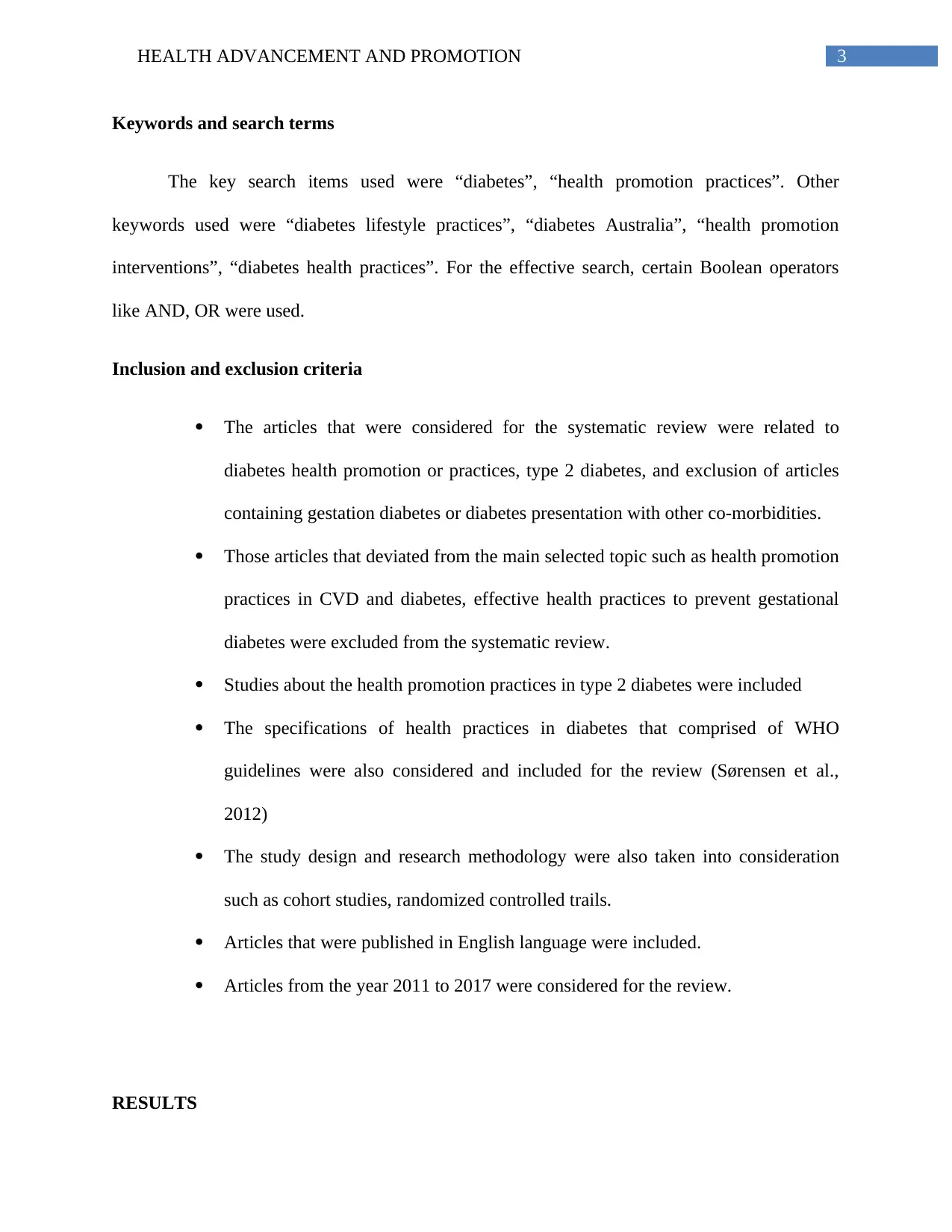
3HEALTH ADVANCEMENT AND PROMOTION
Keywords and search terms
The key search items used were “diabetes”, “health promotion practices”. Other
keywords used were “diabetes lifestyle practices”, “diabetes Australia”, “health promotion
interventions”, “diabetes health practices”. For the effective search, certain Boolean operators
like AND, OR were used.
Inclusion and exclusion criteria
The articles that were considered for the systematic review were related to
diabetes health promotion or practices, type 2 diabetes, and exclusion of articles
containing gestation diabetes or diabetes presentation with other co-morbidities.
Those articles that deviated from the main selected topic such as health promotion
practices in CVD and diabetes, effective health practices to prevent gestational
diabetes were excluded from the systematic review.
Studies about the health promotion practices in type 2 diabetes were included
The specifications of health practices in diabetes that comprised of WHO
guidelines were also considered and included for the review (Sørensen et al.,
2012)
The study design and research methodology were also taken into consideration
such as cohort studies, randomized controlled trails.
Articles that were published in English language were included.
Articles from the year 2011 to 2017 were considered for the review.
RESULTS
Keywords and search terms
The key search items used were “diabetes”, “health promotion practices”. Other
keywords used were “diabetes lifestyle practices”, “diabetes Australia”, “health promotion
interventions”, “diabetes health practices”. For the effective search, certain Boolean operators
like AND, OR were used.
Inclusion and exclusion criteria
The articles that were considered for the systematic review were related to
diabetes health promotion or practices, type 2 diabetes, and exclusion of articles
containing gestation diabetes or diabetes presentation with other co-morbidities.
Those articles that deviated from the main selected topic such as health promotion
practices in CVD and diabetes, effective health practices to prevent gestational
diabetes were excluded from the systematic review.
Studies about the health promotion practices in type 2 diabetes were included
The specifications of health practices in diabetes that comprised of WHO
guidelines were also considered and included for the review (Sørensen et al.,
2012)
The study design and research methodology were also taken into consideration
such as cohort studies, randomized controlled trails.
Articles that were published in English language were included.
Articles from the year 2011 to 2017 were considered for the review.
RESULTS
Paraphrase This Document
Need a fresh take? Get an instant paraphrase of this document with our AI Paraphraser
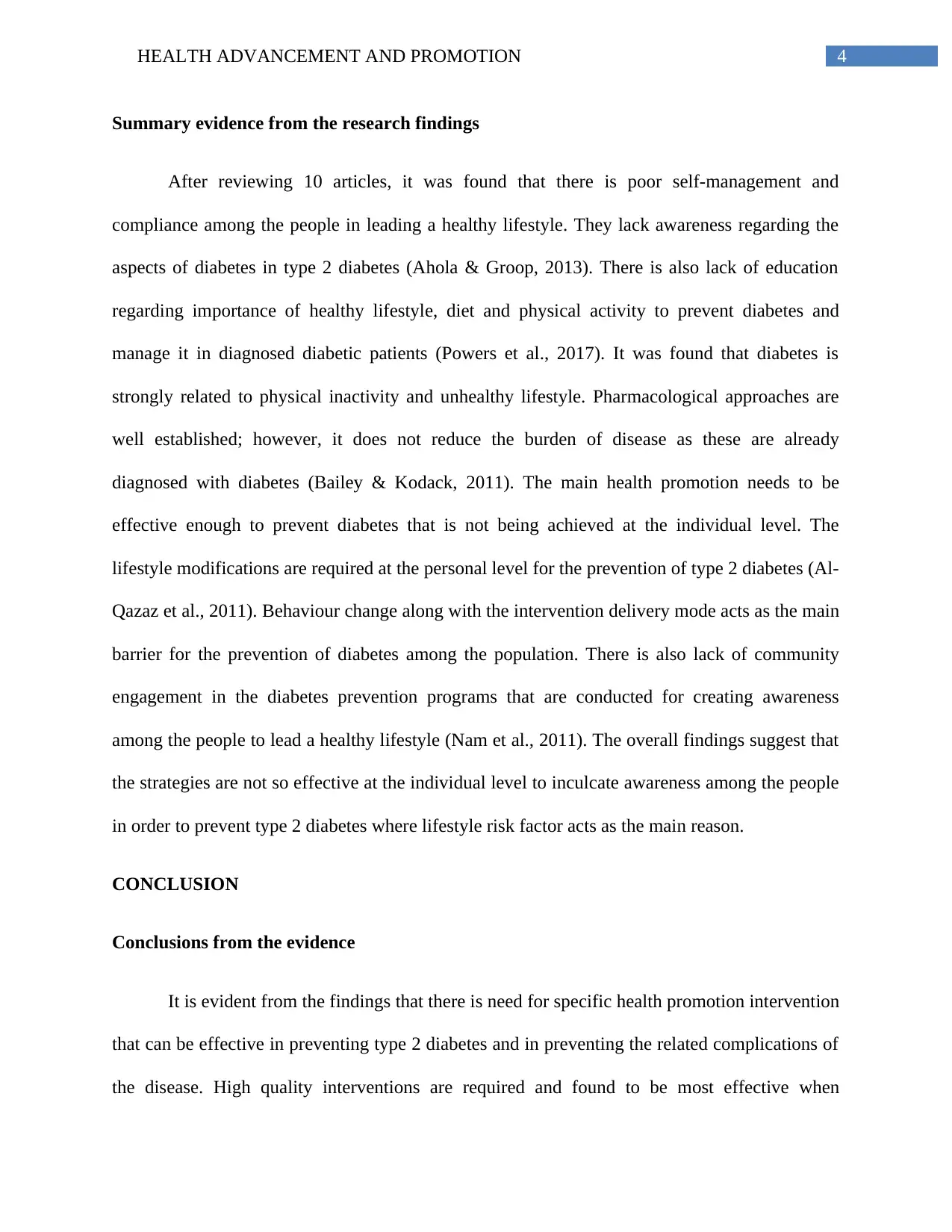
4HEALTH ADVANCEMENT AND PROMOTION
Summary evidence from the research findings
After reviewing 10 articles, it was found that there is poor self-management and
compliance among the people in leading a healthy lifestyle. They lack awareness regarding the
aspects of diabetes in type 2 diabetes (Ahola & Groop, 2013). There is also lack of education
regarding importance of healthy lifestyle, diet and physical activity to prevent diabetes and
manage it in diagnosed diabetic patients (Powers et al., 2017). It was found that diabetes is
strongly related to physical inactivity and unhealthy lifestyle. Pharmacological approaches are
well established; however, it does not reduce the burden of disease as these are already
diagnosed with diabetes (Bailey & Kodack, 2011). The main health promotion needs to be
effective enough to prevent diabetes that is not being achieved at the individual level. The
lifestyle modifications are required at the personal level for the prevention of type 2 diabetes (Al-
Qazaz et al., 2011). Behaviour change along with the intervention delivery mode acts as the main
barrier for the prevention of diabetes among the population. There is also lack of community
engagement in the diabetes prevention programs that are conducted for creating awareness
among the people to lead a healthy lifestyle (Nam et al., 2011). The overall findings suggest that
the strategies are not so effective at the individual level to inculcate awareness among the people
in order to prevent type 2 diabetes where lifestyle risk factor acts as the main reason.
CONCLUSION
Conclusions from the evidence
It is evident from the findings that there is need for specific health promotion intervention
that can be effective in preventing type 2 diabetes and in preventing the related complications of
the disease. High quality interventions are required and found to be most effective when
Summary evidence from the research findings
After reviewing 10 articles, it was found that there is poor self-management and
compliance among the people in leading a healthy lifestyle. They lack awareness regarding the
aspects of diabetes in type 2 diabetes (Ahola & Groop, 2013). There is also lack of education
regarding importance of healthy lifestyle, diet and physical activity to prevent diabetes and
manage it in diagnosed diabetic patients (Powers et al., 2017). It was found that diabetes is
strongly related to physical inactivity and unhealthy lifestyle. Pharmacological approaches are
well established; however, it does not reduce the burden of disease as these are already
diagnosed with diabetes (Bailey & Kodack, 2011). The main health promotion needs to be
effective enough to prevent diabetes that is not being achieved at the individual level. The
lifestyle modifications are required at the personal level for the prevention of type 2 diabetes (Al-
Qazaz et al., 2011). Behaviour change along with the intervention delivery mode acts as the main
barrier for the prevention of diabetes among the population. There is also lack of community
engagement in the diabetes prevention programs that are conducted for creating awareness
among the people to lead a healthy lifestyle (Nam et al., 2011). The overall findings suggest that
the strategies are not so effective at the individual level to inculcate awareness among the people
in order to prevent type 2 diabetes where lifestyle risk factor acts as the main reason.
CONCLUSION
Conclusions from the evidence
It is evident from the findings that there is need for specific health promotion intervention
that can be effective in preventing type 2 diabetes and in preventing the related complications of
the disease. High quality interventions are required and found to be most effective when
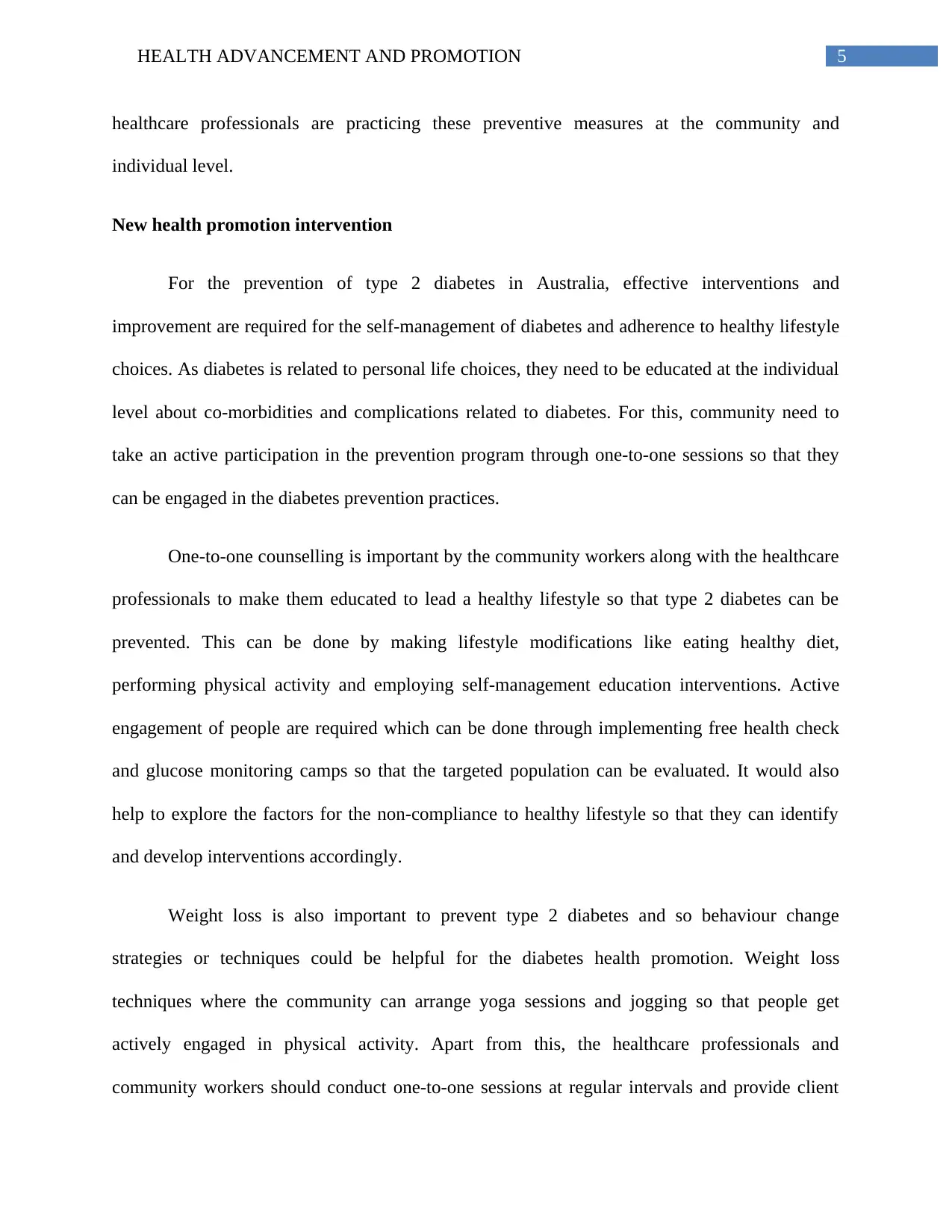
5HEALTH ADVANCEMENT AND PROMOTION
healthcare professionals are practicing these preventive measures at the community and
individual level.
New health promotion intervention
For the prevention of type 2 diabetes in Australia, effective interventions and
improvement are required for the self-management of diabetes and adherence to healthy lifestyle
choices. As diabetes is related to personal life choices, they need to be educated at the individual
level about co-morbidities and complications related to diabetes. For this, community need to
take an active participation in the prevention program through one-to-one sessions so that they
can be engaged in the diabetes prevention practices.
One-to-one counselling is important by the community workers along with the healthcare
professionals to make them educated to lead a healthy lifestyle so that type 2 diabetes can be
prevented. This can be done by making lifestyle modifications like eating healthy diet,
performing physical activity and employing self-management education interventions. Active
engagement of people are required which can be done through implementing free health check
and glucose monitoring camps so that the targeted population can be evaluated. It would also
help to explore the factors for the non-compliance to healthy lifestyle so that they can identify
and develop interventions accordingly.
Weight loss is also important to prevent type 2 diabetes and so behaviour change
strategies or techniques could be helpful for the diabetes health promotion. Weight loss
techniques where the community can arrange yoga sessions and jogging so that people get
actively engaged in physical activity. Apart from this, the healthcare professionals and
community workers should conduct one-to-one sessions at regular intervals and provide client
healthcare professionals are practicing these preventive measures at the community and
individual level.
New health promotion intervention
For the prevention of type 2 diabetes in Australia, effective interventions and
improvement are required for the self-management of diabetes and adherence to healthy lifestyle
choices. As diabetes is related to personal life choices, they need to be educated at the individual
level about co-morbidities and complications related to diabetes. For this, community need to
take an active participation in the prevention program through one-to-one sessions so that they
can be engaged in the diabetes prevention practices.
One-to-one counselling is important by the community workers along with the healthcare
professionals to make them educated to lead a healthy lifestyle so that type 2 diabetes can be
prevented. This can be done by making lifestyle modifications like eating healthy diet,
performing physical activity and employing self-management education interventions. Active
engagement of people are required which can be done through implementing free health check
and glucose monitoring camps so that the targeted population can be evaluated. It would also
help to explore the factors for the non-compliance to healthy lifestyle so that they can identify
and develop interventions accordingly.
Weight loss is also important to prevent type 2 diabetes and so behaviour change
strategies or techniques could be helpful for the diabetes health promotion. Weight loss
techniques where the community can arrange yoga sessions and jogging so that people get
actively engaged in physical activity. Apart from this, the healthcare professionals and
community workers should conduct one-to-one sessions at regular intervals and provide client
⊘ This is a preview!⊘
Do you want full access?
Subscribe today to unlock all pages.

Trusted by 1+ million students worldwide
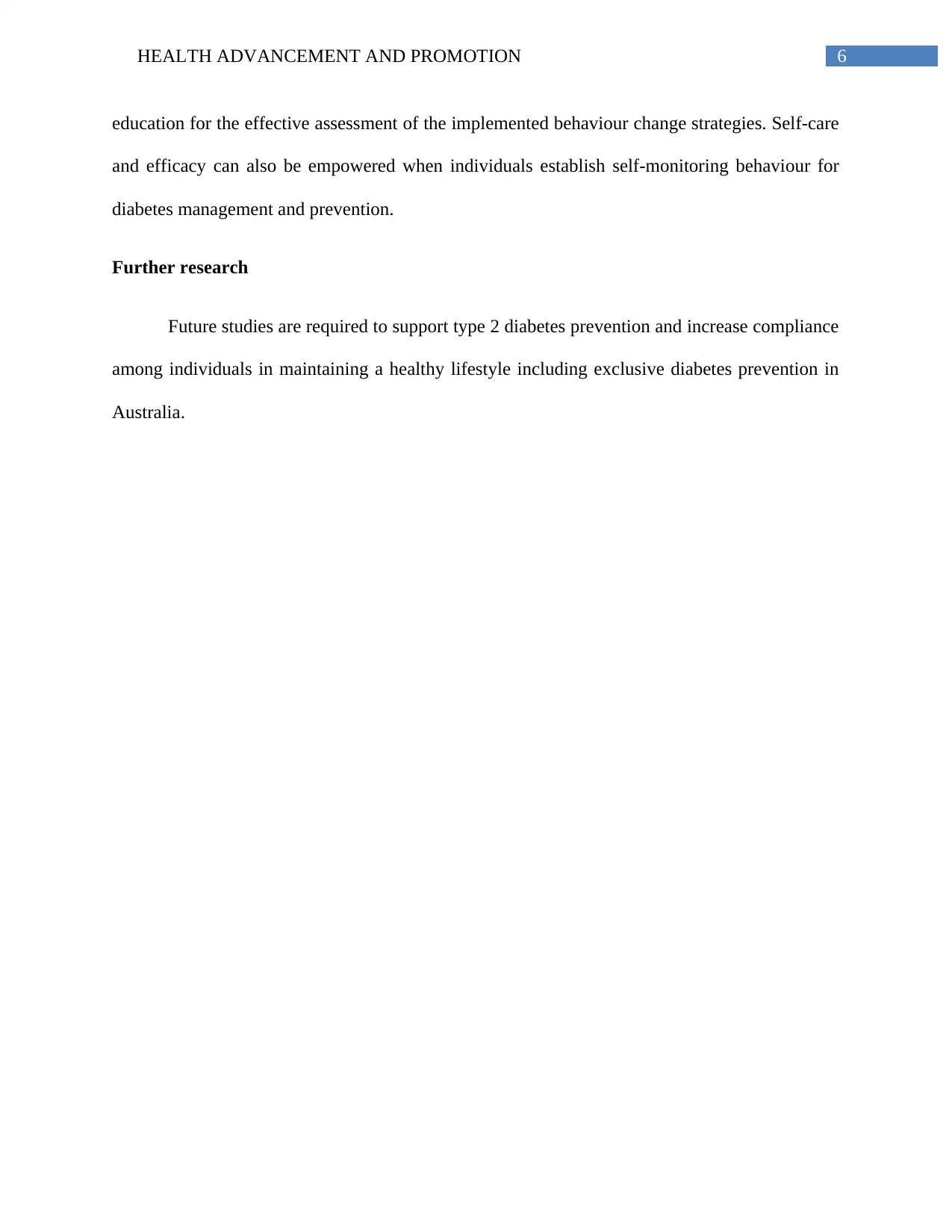
6HEALTH ADVANCEMENT AND PROMOTION
education for the effective assessment of the implemented behaviour change strategies. Self-care
and efficacy can also be empowered when individuals establish self-monitoring behaviour for
diabetes management and prevention.
Further research
Future studies are required to support type 2 diabetes prevention and increase compliance
among individuals in maintaining a healthy lifestyle including exclusive diabetes prevention in
Australia.
education for the effective assessment of the implemented behaviour change strategies. Self-care
and efficacy can also be empowered when individuals establish self-monitoring behaviour for
diabetes management and prevention.
Further research
Future studies are required to support type 2 diabetes prevention and increase compliance
among individuals in maintaining a healthy lifestyle including exclusive diabetes prevention in
Australia.
Paraphrase This Document
Need a fresh take? Get an instant paraphrase of this document with our AI Paraphraser
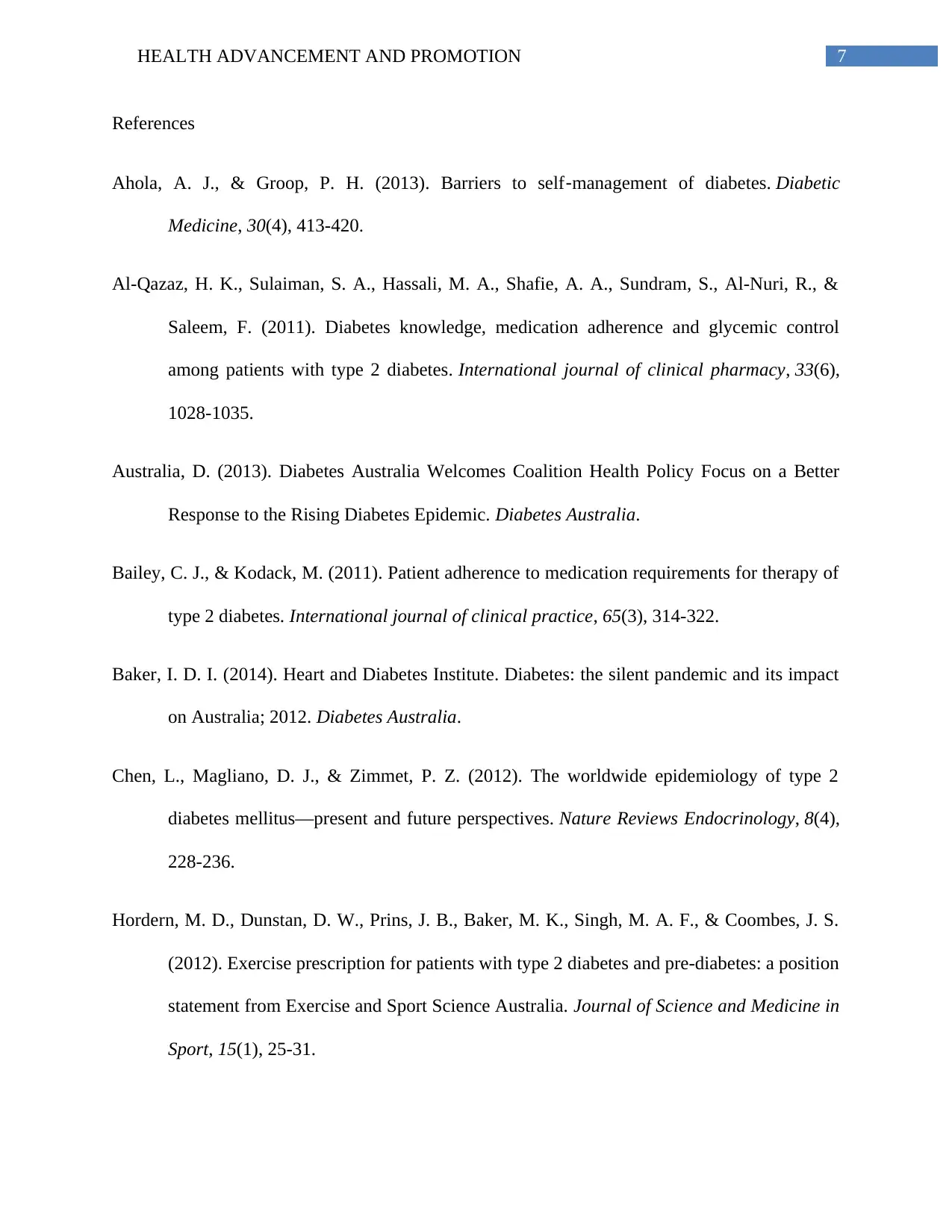
7HEALTH ADVANCEMENT AND PROMOTION
References
Ahola, A. J., & Groop, P. H. (2013). Barriers to self‐management of diabetes. Diabetic
Medicine, 30(4), 413-420.
Al-Qazaz, H. K., Sulaiman, S. A., Hassali, M. A., Shafie, A. A., Sundram, S., Al-Nuri, R., &
Saleem, F. (2011). Diabetes knowledge, medication adherence and glycemic control
among patients with type 2 diabetes. International journal of clinical pharmacy, 33(6),
1028-1035.
Australia, D. (2013). Diabetes Australia Welcomes Coalition Health Policy Focus on a Better
Response to the Rising Diabetes Epidemic. Diabetes Australia.
Bailey, C. J., & Kodack, M. (2011). Patient adherence to medication requirements for therapy of
type 2 diabetes. International journal of clinical practice, 65(3), 314-322.
Baker, I. D. I. (2014). Heart and Diabetes Institute. Diabetes: the silent pandemic and its impact
on Australia; 2012. Diabetes Australia.
Chen, L., Magliano, D. J., & Zimmet, P. Z. (2012). The worldwide epidemiology of type 2
diabetes mellitus—present and future perspectives. Nature Reviews Endocrinology, 8(4),
228-236.
Hordern, M. D., Dunstan, D. W., Prins, J. B., Baker, M. K., Singh, M. A. F., & Coombes, J. S.
(2012). Exercise prescription for patients with type 2 diabetes and pre-diabetes: a position
statement from Exercise and Sport Science Australia. Journal of Science and Medicine in
Sport, 15(1), 25-31.
References
Ahola, A. J., & Groop, P. H. (2013). Barriers to self‐management of diabetes. Diabetic
Medicine, 30(4), 413-420.
Al-Qazaz, H. K., Sulaiman, S. A., Hassali, M. A., Shafie, A. A., Sundram, S., Al-Nuri, R., &
Saleem, F. (2011). Diabetes knowledge, medication adherence and glycemic control
among patients with type 2 diabetes. International journal of clinical pharmacy, 33(6),
1028-1035.
Australia, D. (2013). Diabetes Australia Welcomes Coalition Health Policy Focus on a Better
Response to the Rising Diabetes Epidemic. Diabetes Australia.
Bailey, C. J., & Kodack, M. (2011). Patient adherence to medication requirements for therapy of
type 2 diabetes. International journal of clinical practice, 65(3), 314-322.
Baker, I. D. I. (2014). Heart and Diabetes Institute. Diabetes: the silent pandemic and its impact
on Australia; 2012. Diabetes Australia.
Chen, L., Magliano, D. J., & Zimmet, P. Z. (2012). The worldwide epidemiology of type 2
diabetes mellitus—present and future perspectives. Nature Reviews Endocrinology, 8(4),
228-236.
Hordern, M. D., Dunstan, D. W., Prins, J. B., Baker, M. K., Singh, M. A. F., & Coombes, J. S.
(2012). Exercise prescription for patients with type 2 diabetes and pre-diabetes: a position
statement from Exercise and Sport Science Australia. Journal of Science and Medicine in
Sport, 15(1), 25-31.
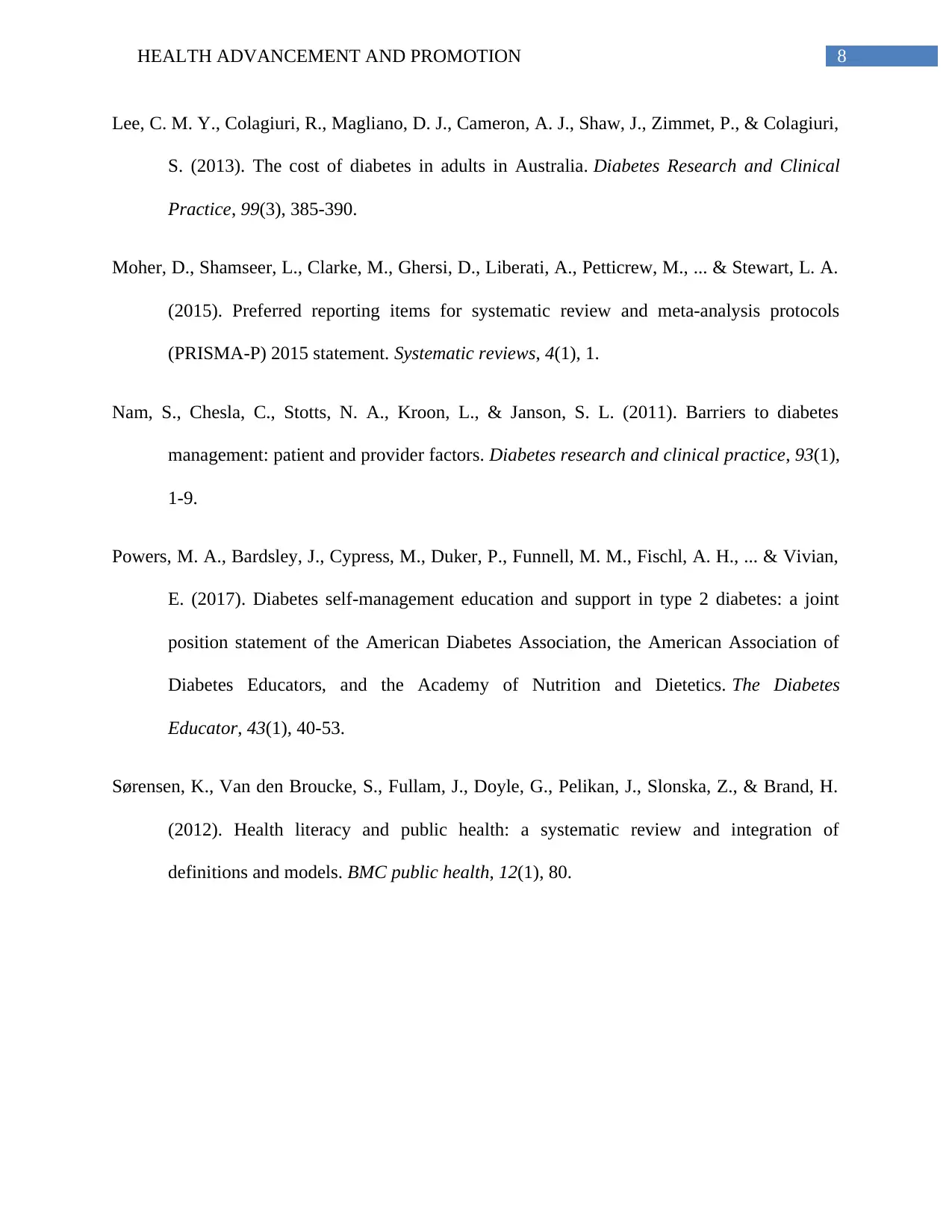
8HEALTH ADVANCEMENT AND PROMOTION
Lee, C. M. Y., Colagiuri, R., Magliano, D. J., Cameron, A. J., Shaw, J., Zimmet, P., & Colagiuri,
S. (2013). The cost of diabetes in adults in Australia. Diabetes Research and Clinical
Practice, 99(3), 385-390.
Moher, D., Shamseer, L., Clarke, M., Ghersi, D., Liberati, A., Petticrew, M., ... & Stewart, L. A.
(2015). Preferred reporting items for systematic review and meta-analysis protocols
(PRISMA-P) 2015 statement. Systematic reviews, 4(1), 1.
Nam, S., Chesla, C., Stotts, N. A., Kroon, L., & Janson, S. L. (2011). Barriers to diabetes
management: patient and provider factors. Diabetes research and clinical practice, 93(1),
1-9.
Powers, M. A., Bardsley, J., Cypress, M., Duker, P., Funnell, M. M., Fischl, A. H., ... & Vivian,
E. (2017). Diabetes self-management education and support in type 2 diabetes: a joint
position statement of the American Diabetes Association, the American Association of
Diabetes Educators, and the Academy of Nutrition and Dietetics. The Diabetes
Educator, 43(1), 40-53.
Sørensen, K., Van den Broucke, S., Fullam, J., Doyle, G., Pelikan, J., Slonska, Z., & Brand, H.
(2012). Health literacy and public health: a systematic review and integration of
definitions and models. BMC public health, 12(1), 80.
Lee, C. M. Y., Colagiuri, R., Magliano, D. J., Cameron, A. J., Shaw, J., Zimmet, P., & Colagiuri,
S. (2013). The cost of diabetes in adults in Australia. Diabetes Research and Clinical
Practice, 99(3), 385-390.
Moher, D., Shamseer, L., Clarke, M., Ghersi, D., Liberati, A., Petticrew, M., ... & Stewart, L. A.
(2015). Preferred reporting items for systematic review and meta-analysis protocols
(PRISMA-P) 2015 statement. Systematic reviews, 4(1), 1.
Nam, S., Chesla, C., Stotts, N. A., Kroon, L., & Janson, S. L. (2011). Barriers to diabetes
management: patient and provider factors. Diabetes research and clinical practice, 93(1),
1-9.
Powers, M. A., Bardsley, J., Cypress, M., Duker, P., Funnell, M. M., Fischl, A. H., ... & Vivian,
E. (2017). Diabetes self-management education and support in type 2 diabetes: a joint
position statement of the American Diabetes Association, the American Association of
Diabetes Educators, and the Academy of Nutrition and Dietetics. The Diabetes
Educator, 43(1), 40-53.
Sørensen, K., Van den Broucke, S., Fullam, J., Doyle, G., Pelikan, J., Slonska, Z., & Brand, H.
(2012). Health literacy and public health: a systematic review and integration of
definitions and models. BMC public health, 12(1), 80.
⊘ This is a preview!⊘
Do you want full access?
Subscribe today to unlock all pages.

Trusted by 1+ million students worldwide
1 out of 9
Related Documents
Your All-in-One AI-Powered Toolkit for Academic Success.
+13062052269
info@desklib.com
Available 24*7 on WhatsApp / Email
![[object Object]](/_next/static/media/star-bottom.7253800d.svg)
Unlock your academic potential
Copyright © 2020–2025 A2Z Services. All Rights Reserved. Developed and managed by ZUCOL.





